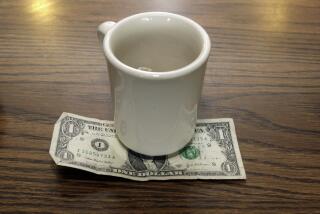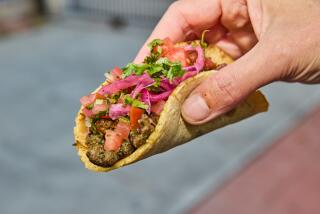Gold: It’s Nutrition-Free
- Share via
The least nutritious mineral has to be gold, because it’s nonreactive. It scarcely ever combines with other elements.
But just because it’s so inspiringly incorruptible, at various times people have thought it was a good idea to put some on their food, either to suggest nobility or (they hoped) bolster their health. Fortunately for their pocketbooks, gold is highly malleable and can be thriftily beaten down to 1/250,000 inch thick.
Gold leaf ( sone ka varaq ) is still used in India on special-occasion dishes, though silver leaf ( varaq ) is cheaper and more common. And there are still a few old-time European liqueurs that contain a sprinkle of gold leaf, such as the caraway-flavored Danziger Goldwasser.
It was in the Middle Ages and the Renaissance that Europeans were really into gold cuisine. Of course, when cooks wanted to gild a roast, they usually faked it with saffron and egg yolks. Gold leaf is so thin and light it has to be handled in a very quiet environment--it will fly away at the slightest breath of air. Going from a roaring hearth fire to a drafty hall, you could experience a gold drain.
The favorite thing to do with gold was to mold figures out of marzipan and apply gold leaf to them. Gingerbread, which in medieval times was more like a cookie than a cake, also got the gold leaf treatment. The technique was to coat the gingerbread with egg white when it was still hot and then dab it with leaf, which would be attached, in effect, by fried egg.
Incidentally, this is basically the same technique used by bookbinders to apply gold leaf to leather bindings, except that they don’t bake the book--they just heat the area of leather in question with a small hand tool. In the gold leaf context, egg white has its own special glittery name: glair.
More to Read
Eat your way across L.A.
Get our weekly Tasting Notes newsletter for reviews, news and more.
You may occasionally receive promotional content from the Los Angeles Times.






